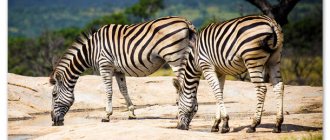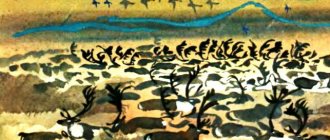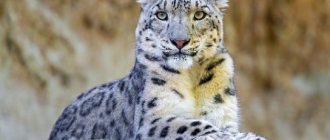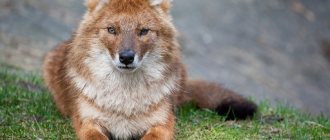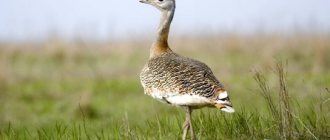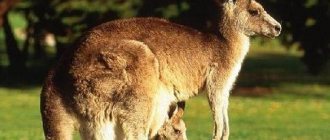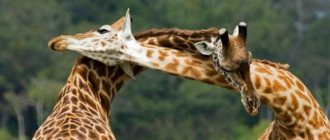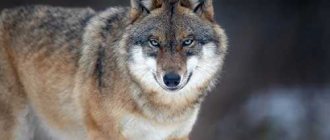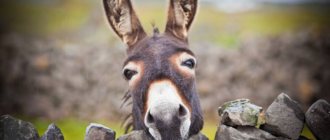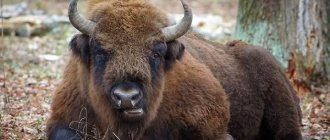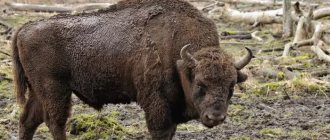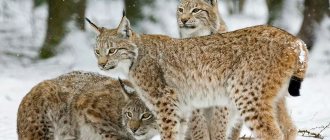- Reports and messages
- Animals
- Elk
One of the largest animals living in the forest is the elk.
The animal has quite a lot of weight, and its height reaches up to 2 meters. Moose are most often dark brown in color, have a huge body and long legs. The animal's head is round, with ears sticking out. Males differ from females in their horns. It is believed that the older a moose gets, the more impressive its antlers grow. The horns themselves are very massive. They give the animal some grandeur. They grow from spring until autumn, and when winter comes, the elk sheds its antlers, giving itself a break from them. Very often, because of their beautiful antlers, moose become good prey for hunters and poachers. Elk live among forests, but sometimes they are spotted in the steppes and tundra. These animals are very large and clumsy, but this does not prevent them from moving along the rocks. When it comes to food, moose seem to be unpretentious. They prefer to feed on bushes, grass and young trees. Sometimes they go in search of mushrooms and even river algae. In summer, moose will have no difficulty finding food; in winter, things are a little worse. But even here the animal will not disappear. In winter, moose eat acacia, willow, young pine and rowan. In their natural habitat, moose can live for about 15 years, in captivity a little longer - about 25 years.
Elk prefer to stay alone, but when the time comes, they find a mate and have cubs. Sometimes male moose can even fight for their chosen one. Sometimes such battles may not end well. When looking for a female, moose become very aggressive; it is better not to approach them at this time. Most often, a female can give birth to 1 to 2 cubs. Small moose calves appear in the spring; they do not look much like their parents. By autumn, they acquire the color of an adult, become brown, gain weight and grow well.
Animals migrate in groups. First come the females and small calves. After them there will always be males. They come back the other way around. The males can be noticed first, and after them the rest. Moose have many enemies, which they sometimes have to face in order to survive or defend their territory. This is, of course, a bear and a wolf. But probably the most dangerous enemy is the person who hunts an animal without thinking about the consequences.
Description of moose
Animals
Author JG Reading time 4 min Updated March 16, 2017
Describing a moose for children will help them write essays using different options and prepare for the lesson.
Content
Moose animal description
Real forest giants live in our forests. These are moose. In the entire appearance of the forest giant one can feel power and strength.
The moose has a large hooked head. The upper thick lip is longer than the lower one. The body is massive, with a hump-like nape. Long ears sensitively pick up the slightest sound. Warm thick wool protects the animal from frost.
The legs of an elk are long, with wide hooves. They allow you to walk through deep snow and swamps.
Moose also run and swim quickly. If you come across a river, the elk will easily swim across it and may even dive under the water for a minute. On a hot day, moose love to go into the water: it’s cool and provides relief from mosquitoes and midges.
The elk also has a decoration - large wide antlers. And so that they do not interfere with running through the forest thickets, the elk raises its head, as if placing its horns on its back. True, in winter the elk sheds its decoration.
Babies are born in the spring. Mother moose gently licks her calf and feeds him milk.
Moose are strong and brave. Strong horns and a blow with a hoof will stop an enemy - a wolf or a bear. Everyone who goes to the forest knows that if a moose mother is walking with a calf, it is better not to approach them! And in case of danger, the elk calf will lie low and hide. If you walk nearby, you won’t notice.
These amazing giants live in our forests.
Moose brief description
Elks inhabit various forests and willow thickets along the banks of steppe rivers and lakes
The body length of the elk is up to 3 m, the height at the withers is up to 2.3 m, the tail length is 12-13 cm; weight 360-600 kg. Females are smaller. In appearance, the elk is noticeably different from other deer. His body and neck are short, his withers are high, in the form of a hump. The legs are very elongated, so in order to drink, the elk is forced to go deep into the water or kneel on its front legs. The head is large, hook-nosed, with an overhanging fleshy upper lip. Under the throat there is a soft leathery outgrowth (“earring”), reaching 25-40 cm. The wool is coarse, brownish-black; legs light gray, almost white.
Males have huge spade-shaped horns, which they shed annually in November - December and walk without them until April - May. Females are hornless.
The basis of their diet consists of branches of coniferous trees, various shrubs, berries, mushrooms, and even algae.
Moose run fast, up to 56 km/h; swim well. While looking for aquatic plants, they can keep their heads under water for more than a minute. Of the sense organs, the moose has the best developed hearing and smell; his vision is weak - he cannot see a motionless person at a distance of several tens of meters.
Moose animal description for children
One of the largest animals lives in our forests - elk. He is easy to recognize. Large, powerful legs, hook-nosed muzzle, high withers. Adult males boast large, spade-like horns. But sometimes the elk get tired of the antlers. And he sheds them in November-December and walks without them until May.
The body length of the elk is up to 3 m, the height at the withers is up to 2.3 m, the tail length is 12-13 cm; weight 360-600 kg. Females are smaller. The elk is a sponger; its upper lip is very large. The neck is short, the ears are long and pointed. The coat is brown, with various shades of ash. In summer, the color of the moose's fur is darker.
What does moose eat? Branches of trees and shrubs, marigold, sedge, as well as marsh vegetation. The moose's favorite delicacy is fireweed plants.
In winter, elk feed during the day and sleep at night. In summer, it's the other way around. Hiding from the heat and midges, he rests during the summer day and looks for food at night. At the end of summer, in the mornings and evenings, males make sounds similar to a dull and drawn-out moo.
In the last days of May - early June, a moose cow gives birth to one, rarely two moose calves. Newborns weigh on average 12-14 kilograms.
Origin of the species and description
It is not known exactly where this species of artiodactyls originated. Typical features inherent in elk were found in the early Quaternary period. Its appearance is attributed to the Upper Pliocene and is associated with a related species - the North American Cervalces. One Quaternary species is distinguished, corresponding to the lower Pleistocene – the broad-fronted elk.
It is he who can be called the progenitor of the moose that are found on the territory of the Russian Federation. The ancestors of this species, corresponding in appearance to the modern description, were found during the Neolithic in the steppes of Ukraine, the Lower Volga region and Transcaucasia, on the Black Sea coast, in Ireland and England, Western Europe, but did not move to the Balkans and Apennines.
Video: Moose
The artiodactyl occupies large areas in the northern part of Europe, Asia, and America. By the beginning of the last century, the range had narrowed, but measures to restore the population led to the fact that the elk began to be found again in the forests of Eurasia as far as the Vosges and the mouth of the Rhine. The southern border descends to the Alps and Carpathians, covers part of the steppe zone of the Don basin, Western Transcaucasia, and runs through the forest zone of Siberia up to the Ussuri taiga.
The animal thrives in Norway, Finland and Sweden. In Russia it is found everywhere in the forest zone, except Sakhalin and Kamchatka. Found in northern Mongolia and northeastern China. On the American continent - in Canada. The restored population occupies the entire forest area of the United States. The animal is unsightly in appearance. The head is strongly elongated and sits on a powerful neck. Her artiodactyl is held almost at the level of the humped withers.
The impressive size of the muzzle is given by the large nose with a complex cartilaginous structure. It goes into the upper wrinkled, drooping lip.
The large ears are very mobile and pointed at the top. The tail is half the length of the ear. It completes the sloping croup and is almost invisible. A pouch-like outgrowth called an earring hangs from the neck. It is more developed in males and can reach a length of 40 cm, but more often no more than 25 cm. The earring grows in length until the age of four, then shortens and becomes wider.
Lynx interesting facts. Lynx: interesting facts
The Eurasian lynx is one of the largest representatives of the cat family in Europe. Her brethren live from the deserts of California, Asia, Africa to the snowy forests of Alaska and go farthest than any other member of the cat family to the north on both continents of the former Laurasia. The lynx genus has only 4 species. They are distinguished from other felines by their short tails, tufts on their ears, and sometimes whiskers on their faces. What other interesting facts about lynxes do we know?
Although lynxes are cunning and cautious, their population is in danger of extinction. It's all because of their warm and beautiful fur, which helps the northern cat live in the harshest conditions.
Source
Appearance and features
Photo: Animal moose
The fur of the elk has a black-brown color, without the “mirror” on the back that is usual for its relatives. The neck and withers are covered with longer hair. The legs are lighter in color than the body. The hooves are large, narrow, elongated and pointed. The side hooves are placed quite close to the ground. When moving through soft soil, swamps, or snow, they rest on the surface, redistributing the load and facilitating movement.
Males grow huge horns that spread out to the sides. They grow almost horizontally at the base and have no branches. Towards the ends, there are deer-type appendages, but most of them are located along the edge of the expanding flat section, the so-called “spade”.
The span of the horns reaches 180 cm, and the weight reaches 40 kg. Their rough surface is brown in color. In the European species, the spade has a small number of finger-like processes; in its North American relatives, their number reaches forty. In young individuals, thin, branchless horns grow in the first year of life. Shovels with shoots appear only by the fifth.
The animal sheds its decorations from its head by December, and new ones begin to grow in April. Females are hornless. Adult specimens have a body up to 5 m long, the height at the humpbacked withers can reach up to 2.4 m, weight about 600 kg, females are smaller and lighter than males. In Canada and the Far East, the weight of individual individuals reaches 650 kg. Powerful legs and hooves serve as protection for them.
Large weight and bulkiness do not prevent this long-legged animal from quickly moving through the forest and windfalls, swamps; it can easily overcome a two-meter fence or ravines. The average speed when walking is 9 km/h, when running up to 40 km/h. Moose can cross wide bodies of water (3 km) and dive deep. Cases have been recorded when animals swam across the Rybinsk Reservoir (20 km); Scandinavian and American observers have similar results.
The largest horns
Until 2015, the largest elk antlers were considered to be the trophy of Bering Kennett, who hunted in Kamchatka in 1993.
Horn parameters:
- 171.5 centimeters in span;
- 127.6 centimeters - the length of one horn;
- on the left side there are 13 processes;
- on the right side - 18 processes;
- the width of the left horn (at the rise) is 43.8 centimeters;
- The width of the right horn (at the rise) is 44.9 centimeters.
However, in 2015, Aishparas Arunas, a Lithuanian hunter, came across a larger elk, whose antlers weighed 50 kilograms and were 178 centimeters in diameter.
Where does moose live?
Photo: Elk in the forest
The mammal lives in the forest zone, right up to the tundra. After restoring the almost lost population, it settled again in various types of forests, along overgrown mountains, clearings, raised bogs, and along the banks of reservoirs.
In the summer, the ungulate can go far from the forest, wandering into the steppe or tundra zone. Loves aspen, alder, and clearings with abundant grass.
The animal prefers overgrown oxbow lakes, river channels, and shallow lakes, since in the summer they spend a lot of time in the water or near reservoirs, and loves swimming. It grazes in willow forests, but does not really like the deep taiga. The more diverse the vegetation, the greater the chances of meeting elk here. Mammals in mountainous areas inhabit river valleys, gentle slopes, and do not like very rugged terrain. In the Altai and Sayan Mountains, the vertical range fluctuates 1800-2000 m. The animal can wander into char areas where there are lakes with coastal vegetation.
In swamps, the animal moves to places where the land goes far inland, and then moves along islands, crawling across swampy areas on its belly, with its front legs extended forward. In Altai, they carve out a path in the swamp in dry areas, the depth of which is up to 50 cm. These animals live sedentary lives, staying in one place for a long time if no one bothers them and there is enough food. In summer, an individual plot is larger than a winter one. Ungulates can go beyond the boundaries of their land to salt licks. If there are such places in their areas, then animals visit them in the dark 5-6 times a day.
When the possessions of neighboring individuals intersect, at high densities, the mammals calmly tolerate this and do not expel others, as is the case with most deer families. The exception is moose cows during the first period after calving.
LIFESTYLE
Moose usually live alone or in small groups. In spring and summer, males and females are separated. At this time, females live with their cubs. In summer, moose are found mainly on the plains, near lakes and swamps. When cold weather sets in, animals go to higher ground and seek shelter in the forests.
Winter is a very difficult period for the survival of moose. High snow makes it difficult for moose to both move and find food. Mostly animals walk along beaten paths and feed near roads. In places where there is food, moose unite in large groups. Hunters call such places “moose camps,” and Canadian trappers call them “yards.” A weak elk is potential prey for wolves. Wolves usually attack hungry animals at the end of winter.
What does moose eat?
Photo: Big Moose
This artiodactyl loves tall grass, eats lichens (especially woody ones), and feasts on mushrooms, which are poisonous, from a human point of view. Berries: cranberries, blueberries, and lingonberries are picked and eaten along with the twigs. In the summer, thanks to its high growth, it grabs branches with its powerful lips and rips off the foliage from them.
The elk prefers to feed on leaves and branches:
- aspen;
- rowan;
- bird cherry;
- willows;
- birches;
- ash trees;
- Krushin;
- maples;
- euonymus.
Of the herbaceous plants, the most favorite is fireweed, which grows in abundance in clearings - the favorite places of artiodactyls. Near reservoirs and in the water, it feeds on water lilies, water lilies, marigolds, sorrel, grass grass, calamus, sedge, horsetail and other plants that grow along the banks. In autumn, its diet changes; the animal eats young shoots of trees and bushes, and eats the bark of trees.
With a lack of food, it can gnaw young branches of pine and fir, especially in the second half of winter, but more often it bites branches of willow, aspen, raspberry, birch, rowan, buckthorn, up to 1 cm thick. The ungulate eats bark from young trees during thaws or from the south sides where it heats up and thaws.
In total, the elk’s diet includes:
- up to 149 genera of angiosperms;
- 6 genera of gymnosperms, such as pine, juniper, yew;
- different types of ferns (5 genera);
- lichens (4 genera);
- mushrooms (11 genera);
- algae, such as kelp.
The Evenks call this artiodactyl tree-eater - “moot”, or willow-eater - “shektati”, because it feeds on tree branches. Its common name is “toki,” which superstitious hunters were afraid to use.
During the year, mammals consume up to seven tons of food, of which:
- bark – 700 kg;
- shoots and branches – 4000 kg;
- leaves – 1500 kg;
- herbaceous plants – 700 kg.
In summer, the daily ration can range from 16 kg to 35 kg, and in winter it is about 10 kg. In winter, elk drink little and rarely eat snow, avoiding heat loss, but in summer they can inhale water or aqueous slurry from 15 minutes to an hour, almost without interruption.
Nutrition
In summer they feed on leaves of trees and bushes, grass, and plants that grow in water. In winter they eat branches, pine needles and bark.
They love salt, if they find a natural source of salt, they gladly consume it in the form of salt water, salt soil.
The areas of forest where moose live are hard to miss. Slices are visible on the trees at face level; this is an elk feeding. He cuts off the bark of trees with his lower teeth.
Animals love to eat at night.
There are no upper teeth and they are not growing. There are 8 incisors on the lower jaw.
Features of character and lifestyle
Photo: Elk in summer
Sokhaty is not very smart; when frightened, he always goes ahead in a straight line. In ordinary life he prefers well-trodden paths. Forest giants avoid areas where the snow is deeper than 70 cm and collect on shady slopes, where the layer is looser. The load on the snow is too great and the artiodactyl falls through, although its long legs help it overcome snow-covered areas. Young elk calves follow the tracks of the adult on such cover.
During feeding, the animal stands; when eating food from the surface of the ground, it tries to spread its legs wide and kneel down; small moose calves often crawl while doing this. In case of danger, the animal relies more on its hearing and sense of smell; it sees very poorly and does not notice a motionless person. Moose do not attack people, only in exceptional cases, when they are injured or protecting their cubs.
During the rut, mammals are constantly active. In the cold season they rest up to five times a day, but with heavy snow or at the end of winter up to eight times. At low temperatures, they plunge into the snow, from under which only their heads are visible, and lie for long hours. During strong winds, forest giants hide in thickets. In the 1930s, elk were raised on special farms for use in military operations, and they even attached machine guns to their antlers. They were taught to distinguish Finnish speech from Russian by ear and to give a sign. Animals picked up a person's voice at a distance of more than a kilometer.
In early June, elk are active during the day. With the rise in temperature and the appearance of a large number of horse flies and horseflies, artiodactyls tend to cool, where the breeze blows and there are fewer insects. They can nest in young conifers, in open marshy areas, shallows, and along the banks of reservoirs. In shallow waters, animals lie down in the water, in deeper places they go into it up to their necks. Where there are no bodies of water, the giants lie down in a damp place, but as soon as it warms up, they get up and look for a new one.
Not only does the midge force them to lie down, but high temperatures are poorly tolerated by these artiodactyls, so in the summer they prefer daytime rest.
Social structure and reproduction
Photo: Wild elk
These large ungulates live alone or gather in groups of up to 4 individuals. Females form a herd of up to eight heads; in winter, young bulls can graze with them. With the onset of spring, the animals disperse. In the summer, moose cows walk with calves, sometimes with last year's calves. Some pairs remain after the rut, sometimes they are joined by last year’s calves and adults, forming groups of 6-9 animals. After the rut, males often live separately, and young ones organize small groups. In winter, the herd population increases, especially during the snowy seasons.
It happens that artiodactyls gather in pairs before the start of the rut, at the end of summer. The bull begins to make mooing sounds as he follows the female into heat. At this time, males begin to break off branches and tops of trees with their horns and beat them with their hoofs. Where a moose cow has urinated, they eat the soil and leave a characteristic smell everywhere. At this time, the bulls eat little, their fur is disheveled, and their eyes are bloodshot. They lose caution, become aggressive, and drive away elk calves. The rut can last for a month; it begins earlier in the southern regions, in the north - later, from mid-September. This difference is due to the onset of late spring in the north - a time more favorable for the birth of babies.
During the rut, bulls are usually monogamous. But if the female moose does not respond to courtship, then the male looks for another one. Near the female you can meet several contenders and there are fights between them, often with fatal results. Young moose are ready to mate in the second year, but do not participate in the rut before the age of four, as they cannot compete with adult bulls. Young people enter the mass race later than the “old people.” Pregnancy lasts from 225 to 240 days, one to two calves are born, weighing 6-15 kg, depending on gender and quantity. The color of elk calves is light brown with red. The second cub often dies. After 10 minutes, newborns are already on their feet, but immediately fall.
On the second day they move unsteadily, on the third they are already walking well, and by the fifth day they are running, and after ten days they are even swimming. At first, the cub is in one place, but if the mother runs away, it lies hidden in the grass or under a bush. The female feeds the calf with milk for about four months, until the rut. In individuals that do not participate in mating, lactation continues. From two weeks old, moose calves begin to eat green food. By September they gain weight up to 150 kg.
Natural enemies of moose
Photo: Elk with antlers
Among the elk's main enemies are bears. Most often they attack artiodactyls when they awaken from hibernation. They often chase pregnant females or attack moose calves. Mothers protect their young. A blow from the front limbs is especially dangerous. In this way, an ungulate can defeat a bear or any enemy on the spot.
Wolves are afraid to attack adults; they do so in a pack and only from behind. Most often, children die from gray predators. In a snowy winter, wolves cannot keep up with an elk, even a young one. Through a brown, dense forest or during spring return colds, a flock can easily drive a calf or an emaciated adult. Huge artiodactyls cannot resist the lynx or wolverine, which guard their prey in ambush in a tree. Throwing themselves from above, predators grab onto the neck, cutting through the arteries.
Summer midges, horse flies and gadflies are very annoying to moose. Their larvae can settle in the nasopharynx. When there are large numbers of them, difficulty breathing occurs, the mammal becomes exhausted, as it is difficult for it to eat, and sometimes dies. Horsefly bites cause non-healing ulcers on the legs of animals that bleed.
According to eyewitnesses, there were years when animals, tormented by midges, came out to their homes without reacting to dogs or people. Residents of the villages doused the bitten animals with water and fumigated them with smoke, but they could not save everyone from death.
The moose guards the house instead of the dog. Video (00:03:05)
A resident of the Nizhny Novgorod region got himself an unusual pet. He raised a moose in his own house. I picked him up very little on the street. And now, in order to feed the animal, he has to look for part-time work. They've been going everywhere together for two years now. And into the forest for a walk, and for hunting. They are not afraid of the strength of a wolf pack and the power of a fearless connecting rod. Moose Yasha won't let anyone in. The sociable elk is friends with people, dogs and geese. He adopted habits from his friends. When meeting, he extends not his paw, but his hoof. Likes to listen to the radio and watch TV.
Population and species status
Photo: Animal moose
Due to excessive fishing, the fairly stable population of the largest forest ungulates began to decline since the 19th century. By the beginning of the last century, the animal was exterminated, or almost disappeared, in many regions where it was found previously, both in Eurasia and North America. Temporary bans on hunting and conservation measures led to the gradual restoration of former habitats. Camisoles and riding trousers, which were called “elks”, were previously made from elk skin.
At the end of the 20s, in many regions of Russia no more than a few dozen individuals could be counted. Decrees banning fishing (except in Siberia) led to an increase in the number of livestock in the late 30s. Animals also migrated to more southern regions, where young forests appeared in places of fires and deforestation.
During the Great Patriotic War, the number of artiodactyls in the European part of Russia again decreased significantly. In 1945, a ban on hunting was introduced, and a brutal fight against wolves began. The reduction in the number of gray predators, the organization of protected areas, and the introduction of licensed fishing were the decisive factors that influenced the noticeable increase in the population.
The number of wild ungulates on the territory of the RSFSR was:
- in 1950 - 230 thousand;
- in 1960 — 500 thousand;
- in 1980 — 730 thousand;
- by 1992 - 904 thousand.
Then there was a decline and by 2000 the number was 630 thousand individuals. With a much smaller range, at the same time in the North. There were up to 1 million moose in America, 150 thousand in Norway, 100 thousand in Finland, 300 thousand in Sweden. And this was in countries where the animal had previously been almost exterminated. The global conservation status of this animal is designated as “least concern.”
In Russia, according to experts, even taking into account the interests of forestry, it is possible to increase the elk population to 3 million; now their number is about 700-800 thousand. Although this animal is not in danger of being destroyed, it is worth taking increased care for its safety and increasing its population. Elk can live in captivity to obtain dietary meat, leather, antlers and milk.
Elk or elk
Just the sight of an elk evokes a feeling of admiration in a person. A few centuries ago, moose were worshiped, so images of this animal are found in the sarcophagi of ancient burials, as well as in the dwellings of primitive people, such as caves. Moose have always represented strength and endurance. People simply call them “stalkers,” since the shape of the horns bears some resemblance to ancient agricultural tools.
The scientific name “elk” comes from the Old Church Slavonic language and meant “ols”. This concept was associated with the red color of the fur of moose calves. Siberians simply called the animal “beast”. The North American Indians were distrustful of this “beast,” so they retold the legend of the treacherous moose, but the Canadian Indians considered this “beast” a noble animal. In the city of Vyborg there is a monument to an elk, who at the cost of his life saved the lives of hunters who got lost.
Moose: description
The elk is considered a mammal that represents the order of artiodactyls, the suborder of ruminants, the deer family and the genus of moose. The exact number of subspecies of this noble animal has not yet been established, although it is believed that their number reaches 4 or 8. The largest subspecies are considered to be Alaskan and Eastern European, while the smallest is considered to be Ussuri, which has horns that are not characteristic of this animal, without the characteristic blades.
Appearance
Elk is the largest animal of the deer family. The body length of the elk reaches about 3 meters, with a height at the withers of almost 2 meters 40 centimeters. The mass of these animals is at least half a ton, and males are always larger than females.
Elk also has other differences compared to other representatives of this family. For example:
- The moose has a shorter body and slightly longer legs.
- Horizontal, but not vertical arrangement of horns.
- The elk has a hump-shaped wither.
- The animal has a fairly large head with a characteristic hump in front of the nose, as well as a fleshy upper lip.
- In the throat area of the male there is a soft outgrowth of skin, up to 40 centimeters long, called an “earring”.
Since moose have rather long legs, this creates some problems for the animal. For example, in order for an animal to drink water, an elk has to either go deep or kneel down. Although the moose’s fur is hard to the touch, its undercoat is thick and soft, thanks to which the moose can withstand significant cold. In addition, during the winter the moose’s fur grows to almost 10 centimeters. The moose has the longest hair on the withers and neck, so it seems that the moose has a mane and also a hump. The color of the coat on the upper part is more consistent with black, and then this shade becomes brown on the lower part and lighter closer to the legs. In winter, moose are always lighter in color than in summer.
Elk have the largest antlers of any mammal. Their weight can be about 30 kg, and their span is about 1.8 meters. Moreover, such horns grow exclusively on males, since females do not have horns at all.
At the end of autumn, deer shed their antlers and remain antlerless until spring, after which they begin to grow them again. The oldest moose have the most powerful and most “shoveled” antlers.
Interesting fact! The elk does not shed its antlers on its own, but they fall off on their own due to the fact that they have the least amount of sex hormones in their blood. Lack of hormones leads to the weakening of the place where the horns grow, located at the base of the skull. Shed antlers serve as a source of food for various rodents and birds.
Young moose calves develop antlers upon reaching their first year of life. The first horns are quite soft, and they are also covered with thin skin and velvety wool. Over the next two months, the animal has to endure a lot of negative influences, including bites from annoying insects. After this time, the horns become hard, since blood circulation in them stops.
The process of shedding its horns brings significant relief to the animal, since in winter it does not need them, and moving in forest areas with horns, and even more so in winter, when there is a lot of snow, is not so easy.
Report on the topic Elk for children of grades 1, 2, 4, 3, 5 message
One of the largest animals living in the forest is the elk. The animal has quite a lot of weight, and its height reaches up to 2 meters. Moose are most often dark brown in color, have a huge body and long legs. The animal's head is round, with ears sticking out. Males differ from females in their horns. It is believed that the older a moose gets, the more impressive its antlers grow. The horns themselves are very massive. They give the animal some grandeur. They grow from spring until autumn, and when winter comes, the elk sheds its antlers, giving itself a break from them. Very often, because of their beautiful antlers, moose become good prey for hunters and poachers. Elk live among forests, but sometimes they are spotted in the steppes and tundra. These animals are very large and clumsy, but this does not prevent them from moving along the rocks. When it comes to food, moose seem to be unpretentious. They prefer to feed on bushes, grass and young trees. Sometimes they go in search of mushrooms and even river algae. In summer, moose will have no difficulty finding food; in winter, things are a little worse. But even here the animal will not disappear. In winter, moose eat acacia, willow, young pine and rowan. In their natural habitat, moose can live for about 15 years, in captivity a little longer - about 25 years.
Elk prefer to stay alone, but when the time comes, they find a mate and have cubs. Sometimes male moose can even fight for their chosen one. Sometimes such battles may not end well. When looking for a female, moose become very aggressive; it is better not to approach them at this time. Most often, a female can give birth to 1 to 2 cubs. Small moose calves appear in the spring; they do not look much like their parents. By autumn, they acquire the color of an adult, become brown, gain weight and grow well.
Animals migrate in groups. First come the females and small calves. After them there will always be males. They come back the other way around. The males can be noticed first, and after them the rest. Moose have many enemies, which they sometimes have to face in order to survive or defend their territory. This is, of course, a bear and a wolf. But probably the most dangerous enemy is the person who hunts an animal without thinking about the consequences.
